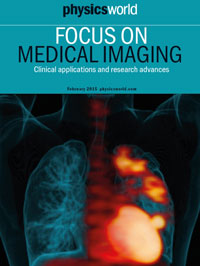By Tami Freeman
Medical imaging is a multidisciplinary science encompassing a wide range of powerful techniques with applications in both patient care and fundamental biological studies. In this latest Physics World focus issue, we examine how imaging technologies such as X-ray computed tomography (CT), magnetic resonance imaging and other nuclear, ultrasound and optical imaging techniques have evolved in recent years. We also take a look at what improvements can be expected in the future.
Created in collaboration with our sister website medicalphysicsweb, the new focus issue on medical imaging can be accessed free of charge in digital-magazine format.
Here’s a quick guide to what you can find in this latest focus issue on medical imaging.
• Current and future imaging trends – Future developments in biomedical imaging will likely focus on understanding how to use images to their full capacity.
 • New ways to make medical isotopes – Novel production techniques help address supply issues of the medical isotope technetium-99m.
• New ways to make medical isotopes – Novel production techniques help address supply issues of the medical isotope technetium-99m.
• Making the invisible visible – A look at how X-ray phase-contrast imaging could transform X-ray imaging in hospitals.
• A clinical take on molecular imaging – Transitioning molecular imaging from a preclinical technique to a standard clinical tool.
• TRAP focuses deep into tissue – A novel light-focusing technique could enable a range of diagnostic and therapeutic applications.
• There’s also a selection of research and industry news, including reports on creating a low-cost X-ray CT scanner and how positron-emission-tomography scans can be used to identify potential new tuberculosis drugs.
You can now enjoy immediate access to the focus issue via the digital edition of the magazine on your desktop or on any iOS or Android smartphone or tablet via the Physics World app, available from the App Store and Google Play.
I hope you find this focus issue stimulating and please do let us have your comments by e-mailing pwld@iop.org or leaving your remarks below.
Trackback: Physics Viewpoint | Physics World 2015 Focus on Medical Imaging now live
I see that the “desktop version” does not include a file in an industry standard format that you can move from place to place. In other words, no PDF file. Pity that.
You have to wonder what publishers have in their heads when they buy the sales pitch of someone pushing their a proprietary publishing package.
Following feedback from users, we decided to move away from a PDF-based approach for the digital edition of Physics World so that we can ensure that it is more efficient, works better on a wide range of devices, including smartphones and tablets, and can support additional content such as audio and video. If you have an Apple or Android device, then the app allows you to download issues for offline reading, so that you can access the content whenever and wherever you may be. Articles from Physics World are still available as individual PDFs for members of the Institute of Physics via a searchable archive at myiop.org.
Dens Milne
Associate Editor, Physics World